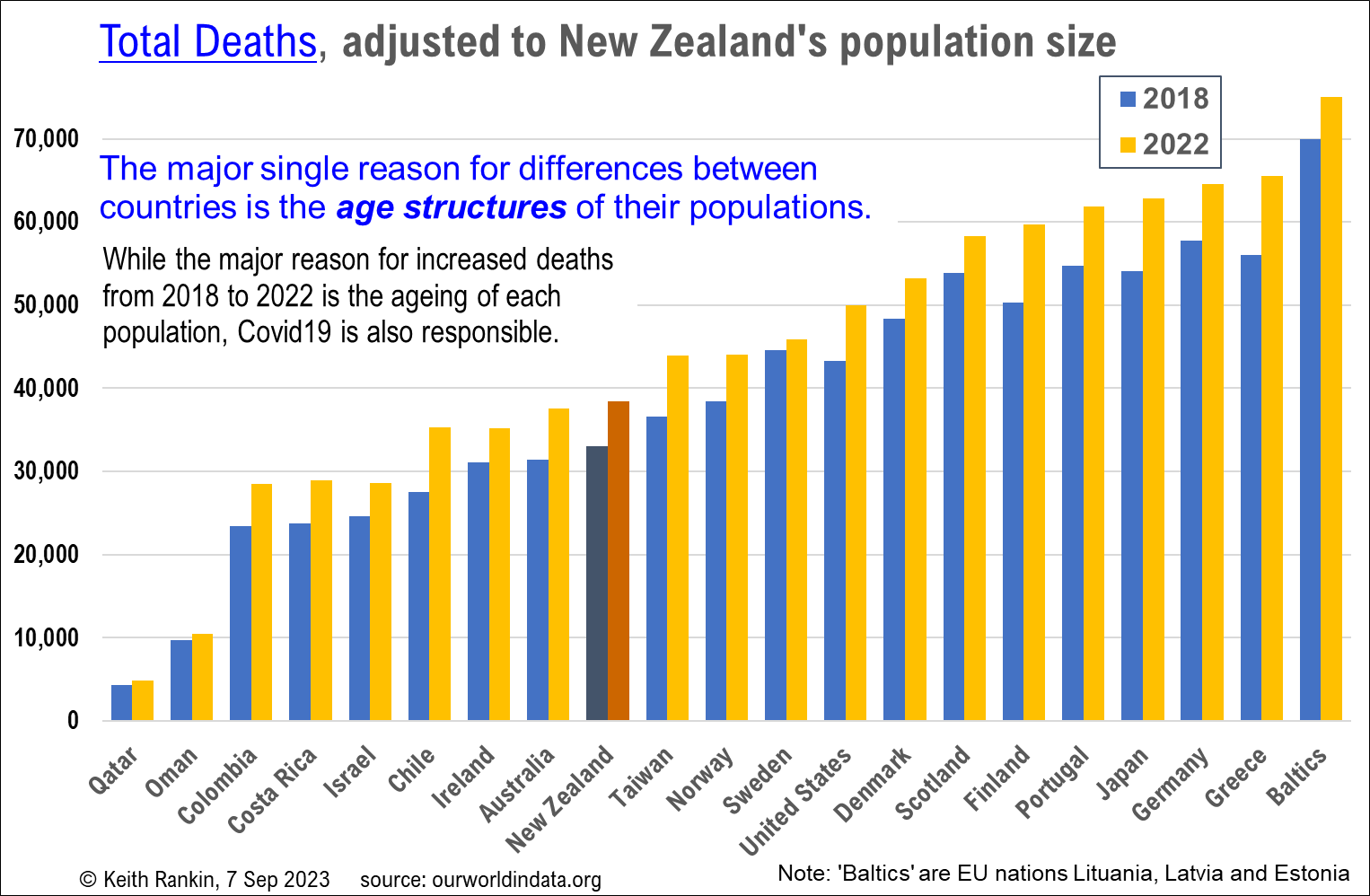Analysis by Keith Rankin.

This chart shows total deaths in a number of comparable countries with high or highish life expectancies. The countries with most deaths have older populations.
New Zealand should perhaps be compared most with Ireland, Scotland, Denmark and Finland; all countries with just over five million people. And with Australia.
Australian mortality has been similar to New Zealand’s in recent years, though, as more New Zealand citizens migrate to Australia, in the next few years New Zealand will age faster than Australia.
Ireland is exceptional because of its relationship with United States’ high technology companies and its full membership of the European Union. Thus Ireland has many elite ‘tech’ workers at present. Further, in past years of difficulty – especially 2008 to 2014 – Ireland was able to unload much of its underclass to other countries. While the health and financial circumstances of Ireland’s sixty- and seventy-somethings requires further investigation, Ireland will neither have had as big a baby bust as New Zealand in the 1930s nor as intense a baby boom from 1946 to 1965. So, it is likely that the numbers of deaths in New Zealand will rise faster in coming years than the number of deaths in Ireland.
The high death numbers in Scotland, Denmark and Finland do not reflect lower life expectancies in those countries. Rather, they reflect populations with comparatively fewer younger people compared to older people. These countries’ mortality numbers in 2018-2022 are the best guide we have to what death numbers will be like in New Zealand in coming years, as the baby bust generation passes on and the 1940s’ and 1950s’ baby boomers reach the days in which they dominate death data.
Most importantly, the experience of these three countries suggests that we will see the demand for health care in New Zealand surge from now on – peaking in the 2030s and 2040s – at a time when current projections show that New Zealand’s healthcare workforce will trough. There seems to have been minimal, if any, demographic analysis of the implication in New Zealand of a baby bust generation giving way to baby boom generations. This is despite record numbers of policy analysts and cost analysts contracted by government.
Some Particular Comments about other countries
I have included Qatar and its near-neighbour Oman to show how low death numbers are at present in small Arabian countries with relatively large numbers of working-age residents. I think that this observation also applies to Israel.
We note also the death incidence in the higher life expectancy countries of Latin America – Costa Rica, Colombia and Chile – on account of their relatively low numbers of people in their eighties.
We note that Portugal and Japan have relatively high numbers of elderly people in their populations. Portugal has been a retirement magnet within Europe, with strong links to the United Kingdom. I have generally been puzzled as to why Japan has so many older people, though we should note that the generation which fought in World War II has largely passed on. I guess that, as in England, many Japanese children in the war were transported into the countryside so that they were not in the cities which suffered very intense bombing from the United States. Overall, Japan is one of the most age imbalanced countries; the low birth rates in recent decades contribute most to this.
Germany is a country which suffered particularly from Covid19 and similar diseases in 2022. But its high 2018 death tally suggests demographic causes which still need unravelling. Despite Germany being a major labour inflow country in Europe, it still has a median age about ten years higher than New Zealand’s (47 compared to 37).
On the flipside of Germany’s role as a labour-inflow country within the European Union, we have Finland and the other Baltic states as outflow countries. Hence the high death tallies in Finland and the Baltics relative to their resident populations.
Neither Finland nor Denmark look particularly happy in this chart. I predict that New Zealand’s death tally will soon be like Finland’s, given both countries’ propensities to lose labour to bigger neighbours. The situation of Greece is similar to that of the Baltic counties; too great a loss of their younger people to the employment centres of the European Union.
Re a few countries not in the chart, I can affirm that both England and Netherlands have population-adjusted death tallies very similar to the United States. And Canada’s adjusted numbers are very similar to Norway’s.
Finally, we should note Sweden, which was neutral in World War II. So Sweden does not have the extreme demographics of older people which New Zealand and other war participant countries exhibit. And, Sweden was less impacted by Covid19.
______________
Keith Rankin (keith at rankin dot nz), trained as an economic historian, is a retired lecturer in Economics and Statistics. He lives in Auckland, New Zealand.








